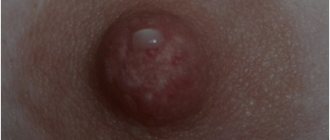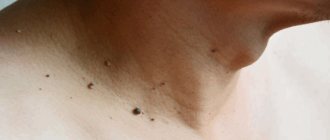Seborrheic warts - causes of formation
The causes of seborrheic warts are unknown. But it is reliably clear that they are not related to the HPV papillomavirus, although their name indicates this. Thus, a seborrheic wart has nothing in common with such epidermal lesions as true condylomas, papillomas and warts.
However, there are some factors that predispose you to developing seborrheic warts:
- Age
. Warts most often appear in people over 35 years of age. Many people have more than a dozen of them; - Genetic predisposition
. The presence of seborrheic warts or other epidermal nevi in immediate family members; - Conditions associated with actinic keratosis
or impaired sebum production.
What is human papillomavirus?
Human Papilloma Virus (HPV) is a virus that can infect the skin and mucous membranes of the mouth, throat, genitals, and anal area. HPV infection is widespread. Most people with HPV do not develop any symptoms and their immune system clears the virus without any treatment. In some cases, HPV can lead to cancer. We don't know why some people get rid of HPV before it causes cancer and others don't.
to come back to the beginning
What does a seborrheic wart look like?
Seborrheic papillomas are characteristic mushroom-shaped skin rashes. However, such a wart can be confused with other skin lesions, such as actinic keratosis or some malignancies, mainly cutaneous melanoma. It also happens the other way around, when skin cancer is mistaken for a harmless seborrheic formation.
Keratinized pigmented lesion
Multiple seborrheic keratomas
Development of seborrheic papilloma
Therefore, diagnosis and treatment of any neoplasms should be carried out strictly by an experienced dermatologist. It is strictly prohibited to independently diagnose yourself, much less remove tumors at home.
Here are the features that distinguish a seborrheic wart from other skin lesions:
- Seborrheic papilloma is well demarcated from healthy skin. It gives the impression of being superimposed on the surface.
- The size of the formation ranges from a few millimeters to several centimeters.
- On the surface of the nipple there are numerous depressions containing an accumulated mass of callus epidermal cells and sebum.
- Depending on the stage of development, the color of the nipple varies from a color similar to healthy skin to dark black, which is not a sign of melanoma.
Seborrheic warts are not accompanied by symptoms such as pain, itching, burning. The exception is mechanical irritation, for example, when changing clothes.
What is atheroma
Simply put, atheroma is a soft bump on the head, usually yellow in color. Both isolated cases of atheroma development and atheromatosis, in which frequent relapses occur, are possible.
In Buddhism, the bulge on the top of the head is a symbol of enlightenment, which is always present in images of Buddha. In real life, things are a little different. If the atheroma is not removed in time, sooner or later it will become inflamed and suppurate. Its symptoms are as follows: when the atheroma is inflamed, it begins to change color to light brown, a “bump” breaks through, and pus is released from it. All this is accompanied by an indescribable aroma, faintly similar to the blooming of a spring meadow.
Naturally, like any purulent process, when atheroma suppurates, immediate surgical intervention is required. But it is better to go to the doctor without waiting for such developments.
Expert comment:
“Bringing atheroma to inflammation is not worth it for many reasons.
Firstly, to treat purulent wounds, the surgeon is forced to make a large incision in order to properly clean them.
Secondly, as a result of excess inflammation, an unsightly keloid scar can form.
So the operation to remove atheroma, when the atheroma is calm, is much easier and requires almost no time for rehabilitation.”
Maxim Vasiliev, plastic surgeon.
Important
Seborrheic warts are benign skin lesions. This means that they cannot turn into cancer cells and be dangerous to health. Seborrheic warts are only an aesthetic problem. Especially when they are on the skin of the face.
The exception is when such a neoplasm is located in a place of constant friction or other traumatic factor. In this case, skin infection may occur. This can result in serious inflammation and even blood poisoning.
Drug treatment of growths on the scalp
First of all, you need to consult a doctor and donate blood for an immunological test. This will help you choose the right medications. Typically, interferon-based products are used to treat growths on the scalp. In addition, they are supplemented with ointments, such as Feresol, creams and ointments based on fluorocyl, salicylic and retinoic acid. You can also analyze the condition of your skin and hair using a trichogram.
Seborrheic papilloma and cryotherapy
One of the methods for removing seborrheic warts is cryotherapy, that is, freezing the skin lesions with liquid nitrogen. The wart dies off when exposed to very low temperatures.
Cryotherapy
After treatment with liquid nitrogen, literally a few days after the procedure, the color of the wart changes to black, and the skin lesion takes the form of a scab (crust), which disappears from the surface after a month.
Unfortunately, the procedure carries the risk of leaving an unsightly scar, so cryotherapy is not suitable for removing facial warts.
What to do if warts appear on your head?
The likelihood that warts will disappear on their own in the near future is very low.
They do not go away even under the influence of mysterious spells, medicinal herbs or other methods that the boundless human imagination can come up with.
Perhaps the warts really are regressing.
But this can happen only in a few years, or even decades.
At the same time, they bother most people.
Even if the wart is overgrown with hair and is not visible, in any case it interferes with cutting and combing.
She is easily injured.
It may bleed, and sometimes the resulting wound festeres.
The wart should be removed.
This procedure does not cause pain, takes a few minutes and allows you to forget about the problem once and for all.
If a person does not see a doctor and is not treated, the wart may increase in size.
This does not pose a direct threat to health.
But subsequent removal requires treatment of a larger area of the head.
There is a higher risk that a scar will appear and hair in this area will no longer grow.
Therefore, it is better to remove a wart on the head earlier, while it is still small.
Seborrheic wart and IPL laser
Another method for removing seborrheic warts is the use of an IPL laser, which completely burns away the skin lesions, leaving a small concave socket.
IPL laser treatment
Within a few days after the procedure, a scab will form, which will fall off after 2-3 weeks. After treatment, a scar may also remain, but, unlike the previous option, it is almost invisible. Therefore, warts on the face are removed with a laser. A similar effect is also achieved by the radio knife, another modern tool designed to remove moles and warts of almost any type.
Is it painful to remove warts?
Removing warts using cryodestruction is painful.
Painful sensations are observed both during the period of removal and after it, when an inflammatory reaction is formed.
If electrocoagulation or laser is used, there is no pain.
Because anesthesia is used.
When a wart is located on the scalp, topical anesthesia is usually used.
A cream containing prilocaine and lidocaine is applied to the skin.
After a few minutes, skin sensitivity disappears.
The doctor can remove the wart, and the patient does not feel anything during the procedure.
After its completion, when the anesthesia wears off, there is no pain either.
Seborrheic wart - surgical treatment
Removal of skin lesions with a surgical scalpel involves removal of the wart at the epidermal level. This method is suitable for large lesions on the body.
Surgery
It is important to understand that the choice of method for removing seborrheic papilloma should be made by a dermatologist. Some tumors may raise doubts about their origin, so it is important to preserve the removed tissue for analysis. In this case, the doctor will choose a surgical method, since the laser and liquid nitrogen completely remove the affected tissue, so there will be nothing to take for analysis.
ONLINE REGISTRATION at the DIANA clinic
You can sign up by calling the toll-free phone number 8-800-707-15-60 or filling out the contact form. In this case, we will contact you ourselves.
How to treat
Conservative treatment of atheroma without surgery is mostly a myth
. Traditional medicine cannot make a tumor disappear without a trace. So even an atheroma that has gone inside under the influence of Vishnevsky ointment will still appear again. In order to avoid a relapse of the unpleasant disease, the atheroma must be removed completely - along with the capsule around it. And only a surgeon can do this.
Therefore, at the first signs of the disease, you need to contact a plastic surgeon. Only this specialist will be able to not only remove atheroma on the head, but also make sure that the consequences in the form of scars and cicatrices do not overshadow your life in the future.
“Before” and on the 12th day after removal of myofibrolipoma of the forehead area. Tips&tricks on the forehead for faster resolution of swelling. Surgeon Vladislav Gladysheva.
Am I contagious?
HPV is not spread by physical contact (such as touching and kissing the cheek or lips), but you can get HPV through vaginal, anal, and oral sex. This means that if you have HPV, your sexual partners may also have the virus. Because most people clear the infection on their own, the chance that your partner will have cancer caused by HPV is very low, even if infected with the high-risk type. If you are diagnosed with cancer caused by HPV, you do not need to change your sexual behavior in any way.
to come back to the beginning
Are there different types of HPV?
Yes, there are different types of HPV. Some types of this virus cause warts to grow on the skin, mouth, or genitals. Other types can lead to cancer. These are called high-risk types. High-risk HPV can cause a variety of cancers, including cancer of the cervix and vulva in women, the penis in men, and the anus. The most common type is cervical cancer. This is why women have a cervical smear (also called a Pap smear) to check for cervical cancer, which includes testing for HPV.
High-risk HPV can also cause head and neck cancer in men and women.
to come back to the beginning
Classification
Classification by tissue from which tumor formation occurs:
- Fatty – liposarcoma;
- Muscular:
- striated muscle tissue - rhabdomyosarcoma,
- unstriated muscle tissue – leiomyosarcoma;
- Vessels:
- circulatory – hemangiosarcoma,
- lymphatic – linfangiosarcoma;
- Connective – fibrosarcoma;
- Synovial membrane – synovial sarcoma;
- Nervous – neurogenic sarcoma;
- Skin – fibrosarcoma.
Examples of soft tissue sarcomas of the head and neck
Kaposi's sarcoma
Osteogenic sarcoma of the alveolar process of the maxilla
Osteogenic sarcoma of the mandible
Pleomorphic sarcoma of the soft tissues of the neck on the right
What can I do to avoid getting HPV and spreading it to someone else?
Condoms and dental dams (a thin, rectangular sheet of latex or silicone that covers the genitals of a woman receiving oral sex) are not as effective against HPV as they are against other sexually transmitted infections (STIs), such as chlamydia and immunodeficiency virus. human (HIV), but their use reduces the likelihood of HPV transmission. Always use condoms or dental dams during vaginal, anal, or oral sex.
You should also get vaccinated against HPV and encourage your partner to do the same.
to come back to the beginning
Kinds
Warts that appear on the head are divided into separate categories. Simple or ordinary types of growths are among the most common types of formations.
In shape they resemble a large mole or genital papilloma.
The color is most often gray-yellow or brown.
Other types of warts on the head include the following:
- Thread-like growths (the name indicates the shape of the growth, and their color is most often pink or flesh-colored).
- Flat types (raise slightly above the skin and have a brownish color).
- Genital condylomas (clearly rise above the surface of the skin; their color can range from flesh-colored to almost black).
- Chicken.
Depending on the type of origin, growths on the head can be keratotic or viral .
The first group is the category of warts, which are most often called seborrheic or age-related. They usually appear in older people. Visually, they resemble moles of different sizes and shapes.
The types described above can appear in women, men and children on:
- legs and feet;
- hands and under the arms;
- face and neck;
- less common on the lips and tongue.
Causes of the disease
Alopecia areata is one of those diseases whose exact cause has not yet been established.
Experts agree that the disease is most often autoimmune in nature: for some reason, the body begins to consider hair follicles as foreign formations. Lymphocytes attack follicle cells until they are destroyed. In patients with diagnosed alopecia areata, immunoglobulins are detected in the structure of the hair follicles, and various immune pathologies are identified. The reasons that trigger the launch of the autoimmune mechanism are varied:
- heredity (if your close relatives had symptoms of the disease, you are at risk);
- hormonal imbalance, disruption of the endocrine system;
- gastrointestinal pathologies leading to malabsorption and nutrient deficiency in the body;
- chronic infectious diseases: sinusitis, tonsillitis, caries, cytoplasmosis, etc.;
- frequent acute respiratory viral infections or other viral infections;
- atopic dermatitis;
- diseases leading to changes in the composition of the blood - coronary heart disease, pathologies of the autonomic system;
- stress mechanisms.
And this is not a complete list of ailments that cause baldness. However, experts tend to consider alopecia areata to be a multifactorial disease - that is, it usually occurs as a result not of any one of these reasons, but of their combination. Therefore, treatment for both women and men does not have a ready-made scheme, but requires an individual approach.
| Attention! Alopecia areata is not contagious, does not harm the general health of a person, causing only aesthetic problems. However, baldness can cause serious mental disorders and provoke depression. |
Should my partner get tested for HPV?
- Women should follow routine women's health recommendations, which include regular cervical smears.
- Men do not need to undergo any special examinations or tests as there are no routine or routine HPV tests available for them.
The chance of your partner developing cancer caused by HPV is very low. If your partner has symptoms or concerns, you should discuss this with your doctor.
to come back to the beginning











